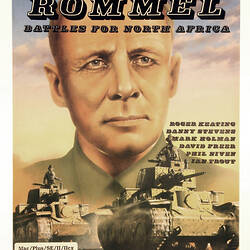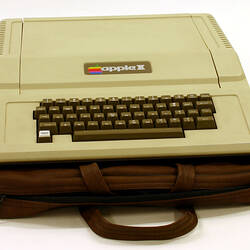Summary
An electronic board-game dealing with battles for the North African Campaign during World War II.
This is an Apple II version using 5 1/4 inch floppy disks There is also is a Macintosh version that uses 3 1/2 inch disks.
This is one of the first series of games in which software micromanaged the actions of the individual units for example battalions or artillery assets.
The series used the same format but different battle scenarios in different theatres of war. In the Macintosh version, titles included Macarthur's War, Halls of Montezuma and Panzer Battles. The Macintosh allowed mouse control and had higher definition graphics. The Apple II version used keyboard control.
The setting is the North African campaign in World War II. There were eight scenarios. There was also a campaign editor that allowed the user to create their own scenarios, as many as they liked. The one player was the divisional or corps commander and the player could play either side. The commander gave general orders to battalions and regiments. The software would then micromanage the orders.
The game had a sound capability that was determined by the limitations of the hardware.
This version was subsequently developed for the Commodore platform computer system C64/128.
In 1983, the donor's parents gave him an Apple II Europlus. He used it for essays, medical school assignments and games. He became especially interested in war games and he stated that an Australian Sydney-based company Strategic Studies Group had the best war games at that time, which he began and continued to collect.
This object was collected because it was designed and produced in Australia by the Strategic Studies Group, commonly known as SSG. SSG is a software development company that makes strategy war games. It is representative of games developed for the Apple II series of computers.
Part of a representative collection of hardware, software, trade literature and promotional material that documents the history of the Apple company, and its contribution to, and impact on the computer industry and society.
Physical Description
A three section cardboard folder with slots for one 5 1/4 inch floppy disk, a poster and booklet. The booklet has 72 pages. The glossy poster contains a series of 8 maps with a legend.
More Information
-
Collection Names
The Apple Company Collection, Internet Macintosh User Group (iMug) Collection
-
Collecting Areas
-
Acquisition Information
Donation from Chee-Yan Hiew, 22 Nov 2006
-
Manufacturer
Strategic Studies Group, Sydney, Greater Sydney, New South Wales, Australia, 1988
-
Format
Magnetic carrier, Floppy disk, 5¼ inch
-
Inscriptions
On Cover " Rommel Battles for North Africa - Roger Keating, Ian Trout, Mark Holman, Phil Niven and David Freer" with a sticker: " A game for the Apple II Family 64 K Disk Apple is a registered TM of Apple Computer Inc." The rear of the folder includes the text " The legend of the Desert Fox Made in Australia" and a photograph of the developers on an inside fold. 1: The booklet: "Rommel Battles for North Africa" 72 pages 2: The poster is called " Battles for North Africa" and includea legend. Floppy Disk Labels: "Rommel Battles for North Africa"- Disk One" Apple II Family ©1988 SSG Version All Rights Reserved
-
Brand Names
-
Classification
-
Category
-
Discipline
-
Type of item
-
Overall Dimensions
235 mm (Length), 180 mm (Width), 20 mm (Height)
-
Keywords
Computer Games, Computer Software, Computers, Computing, Entertainment, World War II, 1939-1945




